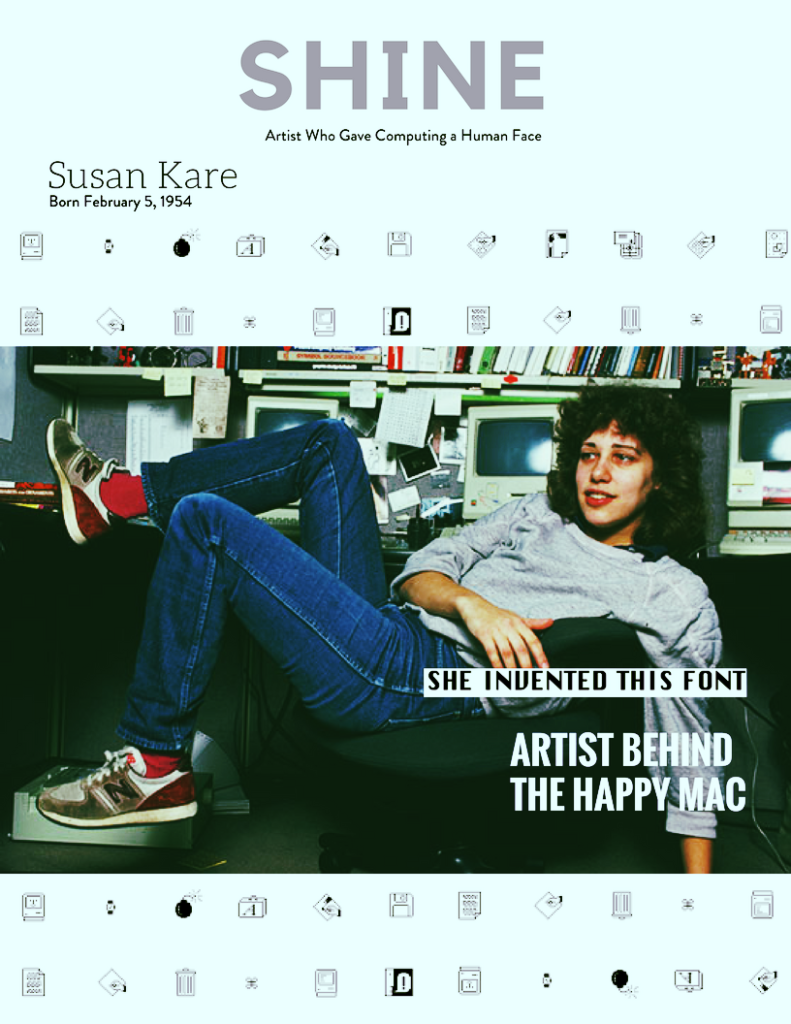Many women in tech have helped shape the modern world, such as Ada Lovelace , Hedy Lamarr or Annie Easley. Today, I wanted to honour a particular woman in tech who’s had such an immense impact on our lives. She is Susan Kare.

Susan Kare is a graphic designer who designed many of the interface elements for the Apple Macintosh in the 1980s. She was also one of the original employees of NeXT working as the Creative Director. Susan Kare was born on February 5, 1954, in Ithaca, New York. While at Harriton High School, she took the time to work at a museum for Harry Loucks, a designer who introduced her to typography and graphic design. In 1975, Kare attended Mount Holyoke College and graduated summa cum laude with a Bachelor’s degree of Honors in Arts. Three years after graduation, she was awarded the Doctor of Philosophy (PhD) from New York University. Afterwards, she relocated to San Francisco and took a curatorial job at DeYoung museum.

Sometime in the early 1980s, Kare received a call from Andy Hertzfeld, her friend, who worked as the lead software architect for the Macintosh team of Apple. Hertzfeld needed a designer for typefaces for the computer and had Kare in mind for the job. Kare knew nothing about computer graphics and had to go to a library to check out some books on typography. Despite this, after acing her interview, she became an original member of the Apple Macintosh design team, where her business card read “Macintosh Artist”. Hertzfeld tasked her with designing the icons and typefaces for the systems and applications to make Macintosh feel less like a device and more like a convenient workstation. Kare was later promoted to Creative Director in Apple Creative Services. In 1986, she joined NeXT as the Creative Director and later became a successful independent graphic designer working with clients such as Microsoft and IBM. Her projects for Microsoft included the card deck for Windows 3.0’s solitaire game, as well as numerous icons and design elements for Windows 3.0. Many of her icons, such as those for Notepad and various Control Panels, remained essentially unchanged by Microsoft until Windows XP. For IBM, she produced icons and design elements for OS/2; for Eazel, she contributed iconography to the Nautilus file manager.

Susan Kara added a unique culture to the Apple computer interface. Let users experience the convenience of human-computer interaction for the first time, which has spread to today. From Dona Bailey’s story, we know that we must not underestimate the power of women and their contribution.
source:
The Origin Of The Apple Command Icon – Tested.Com. [online] Available at:
<https://www.tested.com/tech/mac-os/461757-origin-apple-command-icon/> [Accessed 29 September 2020].
Cooper Hewitt Smithsonian Design Museum. 2020. NDA 20 YRS | Q&A With Susan Kare | Cooper Hewitt, Smithsonian Design Museum. [online] Available at:
<https://www.cooperhewitt.org/2019/09/17/nda-20-yrs-qa-with-susan-kare/#:~:text=Susan%20Kare%20is%20the%20recipient,anyone%20who%20uses%20a%20computer.> [Accessed 29 September 2020].
Susan Kare: The Icon Of Icons Receives Cooper Hewitt’S Lifetime Achievement Award – Typeroom. [online] Available at:
<https://www.typeroom.eu/article/susan-kare-icon-icons-receives-cooper-hewitt-s-lifetime-achievement-award> [Accessed 29 September 2020].
BROWN, E., 2018. Chicago: The Typeface. [online] Chicago magazine. Available at:
<https://www.chicagomag.com/city-life/September-2018/Chicago-the-Typeface/>
BROWN, E., 2018. Chicago: The Typeface. [online] Chicago magazine. Available at:
<https://www.chicagomag.com/city-life/September-2018/Chicago-the-Typeface/>.
